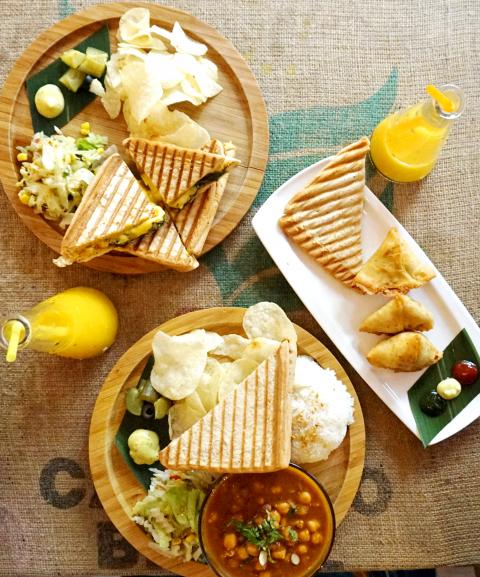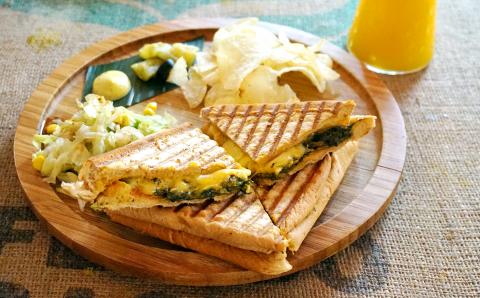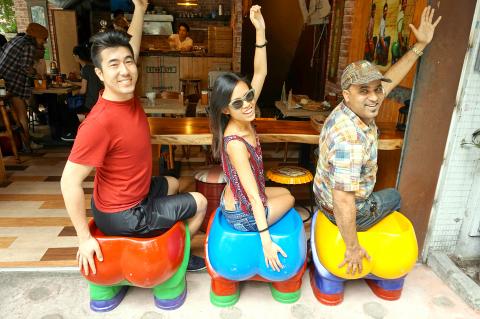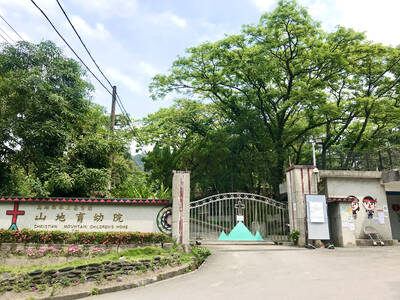You know you’ve reached 3 Idiots Toast and Curry when you see three chairs in the shape of butts.
The little open-air vegetarian eatery is located in an alley directly across the street from the Taipower Building (台電大樓) in Gongguan. Its walls are adorned with red brick walls and the wooden tables are covered with sackcloth, lending it a rustic vibe.
Opened two months ago by Andy Arya, the owner of the Out of India chains, the restaurant is named after the 2009 Bollywood comedy 3 Idiots. Just in case that isn’t clear, hung on the wall is a movie poster showing the three protagonists sitting on butt-shaped chairs striking rodeo poses.

Photo: Dana Ter, Taipei Times
While Bollywood might have a certain appeal to local patrons — 3 Idiots was hugely popular in Taiwan — it was kungfu that brought Arya here 17 years ago. The New Delhi-bred restaurateur, who grew up watching Bruce Lee (李小龍) and Jackie Chan (成龍) movies, planned on visiting his friend, a monk living in Taipei, for two weeks.
“It was a good life,” Arya tells me. “You just pray in the morning, eat, sleep and watch some TV.”
Loving what seemed like the simple life, Arya stayed on, enrolling at the National Taiwan Normal University to study Chinese, all the while scraping funds together to make ends meet. He worked as a dishwasher at a Thai restaurant and taught English at three different schools at the same time. He was even homeless for two nights, resorting to sleeping in Da-an Park when his landlord changed the locks on his apartment because he couldn’t pay the rent.

Photo: Dana Ter, Taipei Times
Though he lived a good life teaching English, Arya felt that it wasn’t his calling and since he had been cooking at home from the age of eight, opening a restaurant wasn’t too crazy an idea.
“I’m Indian. I love cooking. I wanted to open a restaurant that served the food that I enjoyed eating during my childhood,” Arya says.
Having been in the restaurant business for a decade, Arya knows how to sell a concept. Three Idiots is Instagram-worthy. Food is served on round, wooden plates and the fresh fruit juices are served in glasses shaped like lab flasks. Unfortunately, however, the restaurant’s aesthetic was as good as it got.

Photo: Dana Ter, Taipei Times
My friend and I ordered samosas (NT$150), spinach cottage toast (NT$150) and chole masala (NT$260).
The food isn’t quite up to par as Out of India. Perhaps 3 Idiots is trying to be too many things at once — toast and curry, Indian and fusion, vegetarian but packed with carbs.
The samosas are of the standard spiced potato and pea variety — but served with a slice of toast, for some reason. The shell isn’t as crispy and charred as I would have liked, and the filling, though pleasantly savory, is a bit bland and could have been enlivened with a dash of onions or green chili.
Though the intention is to serve “fusion” cuisine, the choice of dipping sauces — mint, mustard and tomato — is mystifying. A side of chutney with tamarind would have provided a far more refreshing complement to the dryness of the samosa shell.
It gets somewhat better with the spinach and cottage cheese toast made with a mixture of homemade cottage cheese, cheddar and mozzarella. The creaminess from the different types of cheese pairs well with the savory spinach and tomatoes, though the cheese could have been a little gooier. The bread, however, was barely toasted. That was the deal breaker.
While I appreciate the side of pickles and the mayonnaise mustard dipping sauce, the side salad with small bits of shredded lettuce and corn is puzzling. (It was probably placed there to appease Taiwanese patrons as that seems to be norm in many restaurants).
The chole masala (or chana masala as it is more commonly known) redeemed the other dishes. The generous portion of chickpea curry with a side of white rice and toast is the most Indian out of all the dishes we sampled and the most satisfying. I can deal with dipping toast instead of naan bread into the curry — it certainly fared better than being eaten with samosas.
The curry, which includes chickpeas, pumpkin, potatoes, almonds, cashews, ginger, turmeric, tomato puree and nine types of spices (though no onion and garlic), boasts a complex, sour citrus flavor. The chickpeas, which simmered in the curry, were both soft and chewy. Though chole masala is known as being a dry dish, I found it to be the most invigorating out of all the food we had.
It seems as if more thought had been put into the concept and decor rather than crafting the actual dishes. Pairing nearly every dish with a slice of toast seems like a stretch — especially when the pairing does not make a lot of sense, as with toast and samosas.
And the toast: Although it is a big part of the menu, 3 Idiots fails to deliver. There is only one variety, which tastes like sliced white bread. Using a different type of bread with a flavor more akin to naan would certainly spice things up.
That being said, the curry is the restaurant’s stand out dish. I just wish there were more curry options on the menu. But I will give 3 Idiots the benefit of the doubt because they plan to introduce more menu items, including hummus and falafel (which might be duds as the restaurant did not exactly succeed in changing my perception of “fusion” food), in the near future.
I did, however, upload a picture of my meal with a rustic filter on Instagram which received a ton of likes.

May 18 to May 24 Pastor Yang Hsu’s (楊煦) congregation was shocked upon seeing the land he chose to build his orphanage. It was surrounded by mountains on three sides, and the only way to access it was to cross a river by foot. The soil was poor due to runoff, and large rocks strewn across the plot prevented much from growing. In addition, there was no running water or electricity. But it was all Yang could afford. He and his Indigenous Atayal wife Lin Feng-ying (林鳳英) had already been caring for 24 orphans in their home, and they were in

On May 2, Chinese Nationalist Party (KMT) Chairman Eric Chu (朱立倫), at a meeting in support of Taipei city councilors at party headquarters, compared President William Lai (賴清德) to Hitler. Chu claimed that unlike any other democracy worldwide in history, no other leader was rooting out opposing parties like Lai and the Democratic Progressive Party (DPP). That his statements are wildly inaccurate was not the point. It was a rallying cry, not a history lesson. This was intentional to provoke the international diplomatic community into a response, which was promptly provided. Both the German and Israeli offices issued statements on Facebook

Even by the standards of Ukraine’s International Legion, which comprises volunteers from over 55 countries, Han has an unusual backstory. Born in Taichung, he grew up in Costa Rica — then one of Taiwan’s diplomatic allies — where a relative worked for the embassy. After attending an American international high school in San Jose, Costa Rica’s capital, Han — who prefers to use only his given name for OPSEC (operations security) reasons — moved to the US in his teens. He attended Penn State University before returning to Taiwan to work in the semiconductor industry in Kaohsiung, where he

President William Lai (賴清德) yesterday delivered an address marking the first anniversary of his presidency. In the speech, Lai affirmed Taiwan’s global role in technology, trade and security. He announced economic and national security initiatives, and emphasized democratic values and cross-party cooperation. The following is the full text of his speech: Yesterday, outside of Beida Elementary School in New Taipei City’s Sanxia District (三峽), there was a major traffic accident that, sadly, claimed several lives and resulted in multiple injuries. The Executive Yuan immediately formed a task force, and last night I personally visited the victims in hospital. Central government agencies and the